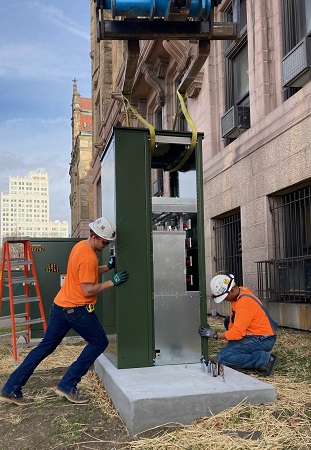 ElectricalConnection.org
ElectricalConnection.org
Connect with Us:
Facebook
LinkedIn
Twitter
YouTube
ST. LOUIS -- As automakers continue the transition from internal combustion engines to electric vehicles (EV), the Electrical Connection is offering guidance to communities on building supportive EV infrastructure and chargers. The Electrical Connection is a partnership of International Brotherhood of Electrical Workers (IBEW) Local 1 and the St. Louis Chapter of the National Electrical Contractors Association (NECA). The partnership helped pioneer the national Electric Vehicle Infrastructure Training Program (EVITP) to ensure reliable planning and installation of EV chargers and infrastructure.

Left to right, Jeremy Edwards, RJP Electric, and Jason Burris, Burris Electric, set a breaker box on the pad at St. Louis city hall that will serve up to 50 EV chargers.
“Our NECA contractors are being engaged by more businesses and civic entities in the effort to expand the EV charging network locally and statewide,” noted Kyle McKenna, executive vice president, St. Louis Chapter NECA. “Businesses and communities want to be reliable destination points in the era of EVs. So with our IBEW partners, we are providing guidance on EV charger infrastructure improvements and stand ready to offer our contractors’ turn-key services to make sure it’s done right.”

RJP Electric installs an EV charger at the St. Charles County Economic Development Council (EDC).
The recommendations and guidance by the Electrical Connection IBEW/NECA partnership include:
· Location & Lifestyle – Unlike gas stations, EV chargers can be placed at virtually any destination point if supported by sufficient electrical infrastructure. Think of it as focused use. The five-minute stop at a gas station is replaced by EV charging while the driver eats lunch, shops or enjoys a sport/entertainment venue. Hence, retail, entertainment, multifamily, office, parks and recreation facilities, transportation hubs such as airports, rail and public transit, existing gas stations, and of course homes can all support EV chargers. The challenge is cost effectively connecting to the electric grid and fortifying power to better support EV chargers in some areas.
· Incentives – Many public utilities now offer financial incentives to encourage the installation of EV chargers. Make sure you line up and secure those incentives before you begin the process of installing EV chargers. IBEW/NECA Electrical Connection contractors can assist in applying for and securing incentives. Simply search its data base of contractors qualified in EV installations. Locally, Ameren Missouri, details its incentives on its website.
· Cost Factors – Unlike the Level 1 charger that comes with the EV and can be plugged in at home, the power needed for fixed public/private EV chargers is more robust. Level 2 chargers use 208/240 volts and DC fast chargers use between 200 and 600 volts. This can impact cost in a number of ways:
o The cost of EV chargers depends on the manufacturer and other issues, such as supply chain. But according to the U.S. Department of Energy, “single connector unit costs range from $300 to $1,500 for Level 1, $400 to $6,500 for Level 2, and $10,000 to $40,000 for DC fast charging.” Other factors influencing cost include networking capabilities that allow data to be sent via the internet, theft deterrence options, output power rating (in kilowatts), number and type of connectors, number of vehicles that can simultaneously charge, and operation and maintenance considerations.
o What power exists on the site? Most existing parking lots will need a more robust and reliable power supply. All new parking planning should include infrastructure improvements to support EV chargers. In many cases, municipal governments – such as the city of St. Louis – require EV-ready infrastructure for all future development.
o Distance of EV chargers to connections to the electric grid. This impacts trenching needs and cabling.
o Metering – some communities and businesses may want separate metering to measure EV charger use. This will need to be installed by the utility.
· Load Calculations – For homeowners, especially those in older homes, load calculation is an important factor. EVs require charging that can take more than three hours, impacting other household demands on load such as cooking. Some older homes may need upgrades to electrical systems. Likewise, commercial interests will need to know what their electrical systems can handle. They may want 10 EV chargers, but only have the capacity to support six chargers without an upgrade. Every location is different. Our contractors can perform site evaluation power needs for EV infrastructure and chargers.
· Permitting and Standards – The U.S. Department of Energy notes that charging station installations must comply with local, state, and national codes and regulations, and be completed by a licensed electrical contractor. IBEW/NECA contractors assist with permitting and build to all relevant codes and regulations, including Article 625 of the National Electrical Code, which covers EV charging systems.
· Other Considerations – Intra-lot traffic flow, EV parking space signage, ADA compliance and how the overall configuration works for EV and non-EV drivers are also important considerations.

Jason Burris, Burris Electric, finalizing new EV charger breaker box at St. Louis city hall in joint project with RJP Electric.
“With our NECA partners, we have been preparing for this day for 11 years,” noted Frank Jacobs, business manager, IBEW Local 1. “Our pioneering EVITP at the IBEW/NECA Electrical Industry Training Center has a full slate of classes this year where we hope to add another 100 to 200 journey workers to the skilled ranks of EV installers.”
Since 2011, the IBEW/NECA Electrical Connection partnership has been readying its workforce and contractors to meet local, state and national needs to support the next generation of travel using EVs. For more information, visit www.electricalconnection.org.
Recent News